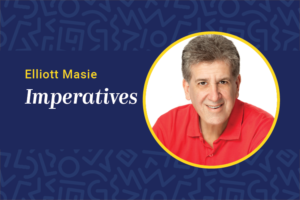
Provide proof that leadership development programs have an impact. Move from agendas that are comfortable and familiar — and don’t be afraid of change.
by Elliott Masie
February 25, 2013
Good news, Sarah. You have been selected for our leadership development track. We will be promoting you to a more senior position in the organization, and in six weeks you will be attending our Next Leaders Development Program.
Is it good news? Certainly the promotion is exciting and welcome, and it will be an honor for Sarah to spend seven to 21 days with other rising leaders in the development program. She will meet the most senior executives of the organization, spend time in classrooms with nationally known management experts and be part of an intensive coaching/360 feedback program along with a range of other learning and development activities.
So why am I questioning whether this is good news? Any employee would jump at the chance to have this type of attention, development, pampering and exposure. But, what evidence do we have about the impact of these programs on the employee and the organization?
Do organizations know:
• If leadership development programs really build better leaders?
• What leadership or management behaviors the programs are more effective at changing?
• If participants in these programs stay longer, earn more, make better decisions, work more collaboratively, innovate more effectively or increase their status and respect in the organization?
Leadership development programs are often more like induction programs. They bring the emerging leader into the leadership tribe. They trigger the beginning of new relationships between peers and senior executives. They expose the new leader to a fresh set of jargon and leadership language for the organization, cultivating a new fluency.
But again, where is the hard evidence these programs are truly effective? There is often an abundance of level one and two “great experience” feedback data points; however, we rarely see organizations take a harder evidence-based approach that would drive a continuous redesign of leadership activities around the following constructs:
• Classroom versus distributed sessions: What percentage of time in the program is spent in face-to-face seminars/classrooms, live interactive webinars or viewing video asynchronous clips?
• Competency mapping: What are the exit competencies from the leadership program, and how do its various elements contribute to mastery of those targets?
• Compressed versus extended: Many leadership programs are front-loaded at their starts with new assignments. What are alternatives that extend, stretch and integrate the content over months or years in a leader’s new role?
• Lecture versus action labs: What if new leaders had to work and solve a real-time problem within the enterprise — in a pressurized environment — using the experts as consultants rather than teachers during this process?
• Failure allowed: Almost everyone graduates from the leadership programs conducted at the corporate level. But why? Can we experiment with making the target bar higher and allowing one or two rounds of failure on the way to success?
• Personalization: If the organization allowed deep personalization of the leadership development program that was mapped against learner backgrounds, current competencies, styles of learning and upcoming roles, how would that look?
• Performance support elements: What are the key takeaway resources and performance support tools that new leaders should have as they leave the program? Video access to coaches? Daily mobile updates? Weekly lab debriefs? Ongoing, rather than one-time, 360 feedback?
I am not advocating that we disassemble our leadership development programs — they are powerful and potent tools for building the leaders of the future. I am suggesting that we move from agendas that are comfortable, familiar and often part of our tribal rituals to an evidence-based design approach that might change some — or many — things.
Elliott Masie is the chairman and CLO of The Masie Center’s Learning Consortium. He can be reached at editor@CLOmedia.com.




